A Dual-Consequent-Pole Vernier Memory Machine
Abstract
:1. Introduction
2. Machine Topology and Operating Principle
2.1. Machine Configuration
2.2. Dual Magnetic-Gearing Effect
2.3. Field Regulatable Principle
3. Design Considerations
4. Electromagnetic Performance Analysis
5. Conclusions
Acknowledgments
Author Contributions
Conflicts of Interest
References
- Rahman, K.M.; Patel, N.R.; Ward, T.G.; Nagashima, J.M.; Caricchi, F.; Crescimbini, F. Application of direct-drive wheel motor for fuel cell electric and hybrid electric vehicle propulsion system. IEEE Trans. Ind. Appl. 2006, 42, 1185–1192. [Google Scholar] [CrossRef]
- Zhu, Z.Q.; Howe, D. Electrical machines and drives for electric, hybrid and fuel cell vehicles. IEEE Proc. 2007, 95, 746–765. [Google Scholar] [CrossRef]
- Chau, K.T.; Chan, C.C.; Liu, C. Overview of permanent-magnet brushless drives for electric and hybrid electric vehicles. IEEE Trans. Ind. Electron. 2008, 55, 2246–2257. [Google Scholar] [CrossRef] [Green Version]
- Jian, L.; Shi, Y.; Wei, J.; Zheng, Y. Design and analysis of a direct-drive wind power generator with ultra-high torque density. J. Appl. Phys. 2015, 117. [Google Scholar] [CrossRef]
- Liu, C.; Chau, K.T.; Zhang, Z. Novel design of double-stator single-rotor magnetic-geared machines. IEEE Trans. Magn. 2012, 48, 4180–4183. [Google Scholar] [CrossRef] [Green Version]
- Zheng, P.; Song, Z.; Bai, J.; Tong, C.; Yu, B. Research on an axial magnetic-field-modulated brushless double rotor machine. Energies 2013, 6, 4799–4829. [Google Scholar] [CrossRef]
- Zheng, P.; Zhao, Q.; Bai, J.; Yu, B.; Song, Z.; Shang, J. Analysis and design of a transverse-flux dual rotor machine for power-split hybrid electric vehicle applications. Energies 2013, 6, 4548–4568. [Google Scholar] [CrossRef]
- Jian, L.; Chau, K.T.; Jiang, J.Z. A magnetic-geared outer-rotor permanent-magnet brushless machine for wind power generation. IEEE Trans. Ind. Appl. 2009, 3, 954–962. [Google Scholar] [CrossRef]
- Wang, L.; Shen, J.X.; Luk, P.C.K.; Fei, W.-Z.; Wang, C.; Hao, H. Development of a magnetic-geared permanent-magnet brushless motor. IEEE Trans. Magn. 2009, 45, 4578–4581. [Google Scholar] [CrossRef] [Green Version]
- Liu, C.; Chau, K.T.; Qiu, C. Design and analysis of a new magnetic-geared memory machine. IEEE Trans. Appl. Supercond. 2014, 24, 1–5. [Google Scholar]
- Kim, B.; Lipo, T.A. Operation and design principles of a PM vernier motor. IEEE Trans. Ind. Appl. 2014, 50, 3656–3663. [Google Scholar] [CrossRef]
- Li, D.; Qu, R.; Lipo, T.A. High-power-factor vernier permanent-magnet machines. IEEE Trans. Ind. Appl. 2014, 50, 3664–3674. [Google Scholar] [CrossRef]
- Li, J.; Chau, K.T.; Jiang, J.Z.; Liu, C.; Li, W. A new efficient permanent-magnet vernier machine for wind power generation. IEEE Trans. Magn. 2010, 46, 1475–1478. [Google Scholar] [CrossRef] [Green Version]
- Spooner, E.; Haydock, L. Vernier hybrid machines. IEE Proc. Elec. Power Appl. 2003, 6, 655–662. [Google Scholar] [CrossRef]
- Niu, S.; Ho, S.L.; Fu, W.N. A novel stator and rotor dual PM vernier motor with space vector pulse width modulation. IEEE Trans. Magn. 2014, 50, 805–808. [Google Scholar] [CrossRef]
- Jian, L.; Xu, G.; Mi, C.; Chau, K.T.; Chan, C.C. Analytical method for magnetic field calculation in a low-speed permanent-magnet harmonic machine. IEEE Trans. Energy Convers. 2011, 26, 862–870. [Google Scholar] [CrossRef] [Green Version]
- Liu, C.; Zhong, J.; Chau, K.T. A novel flux-controllable vernier permanent-magnet machine. IEEE Transactions Magn. 2011, 47, 4238–4241. [Google Scholar] [CrossRef] [Green Version]
- Ostovic, V. Memory motors. IEEE Ind. Appl. Mag. 2003, 9, 52–61. [Google Scholar] [CrossRef]
- Liu, H.; Lin, H.; Zhu, Z.Q.; Huang, M.; Jin, P. Permanent magnet remagnetization physics of a variable flux memory motor. IEEE Trans. Magn. 2010, 46, 1679–1682. [Google Scholar] [CrossRef]
- Lee, J.H.; Hong, J.P. Permanent magnet demagnetization characteristic analysis of a variable flux memory motor using coupled Preisach modeling and FEM. IEEE Trans. Magn. 2008, 44, 1550–1553. [Google Scholar] [CrossRef]
- Yu, C.; Chau, K.T. Design, analysis, and control of DC-excited memory motors. IEEE Trans. Energy Convers. 2011, 26, 479–489. [Google Scholar] [CrossRef] [Green Version]
- Yang, H.; Lin, H.; Dong, J.; Yan, J.; Huang, Y.; Fang, S. Analysis of a novel switched-flux memory motor employing a time-divisional magnetization strategy. IEEE Trans. Magn. 2014, 50, 849–852. [Google Scholar] [CrossRef]
- Yang, H.; Zhu, Z.Q.; Lin, H.; Fang, S.; Huang, Y. Comparative study of novel variable-flux memory motor having stator permanent magnet topologies. IEEE Trans. Magn. 2015, 51, 8114104. [Google Scholar] [CrossRef]
- Yang, H.; Zhu, Z.Q.; Lin, H.; Fang, S.; Huang, Y. Novel alternative switched flux memory machines having hybrid magnet topologies. In Proceedings of the International Conference on Ecological Vehicle and Renewable Energies (EVER), Monaco, 31 March–2 April 2015; pp. 1–9.
- Yang, H.; Lin, H.; Zhu, Z.Q.; Fang, S.; Huang, Y. Novel flux-regulatable dual-magnet vernier memory machines for electric vehicle propulsion, IEEE Trans. Appl. Supercond. 2014, 24, 0601205. [Google Scholar]
- Yang, H.; Lin, H.; Fang, S.; Zhu, Z.Q.; Huang, Y. Flux-regulatable characteristics analysis of a novel switched-flux surface-mounted PM memory machine. IEEE Trans. Magn. 2014, 50, 8103904. [Google Scholar] [CrossRef]
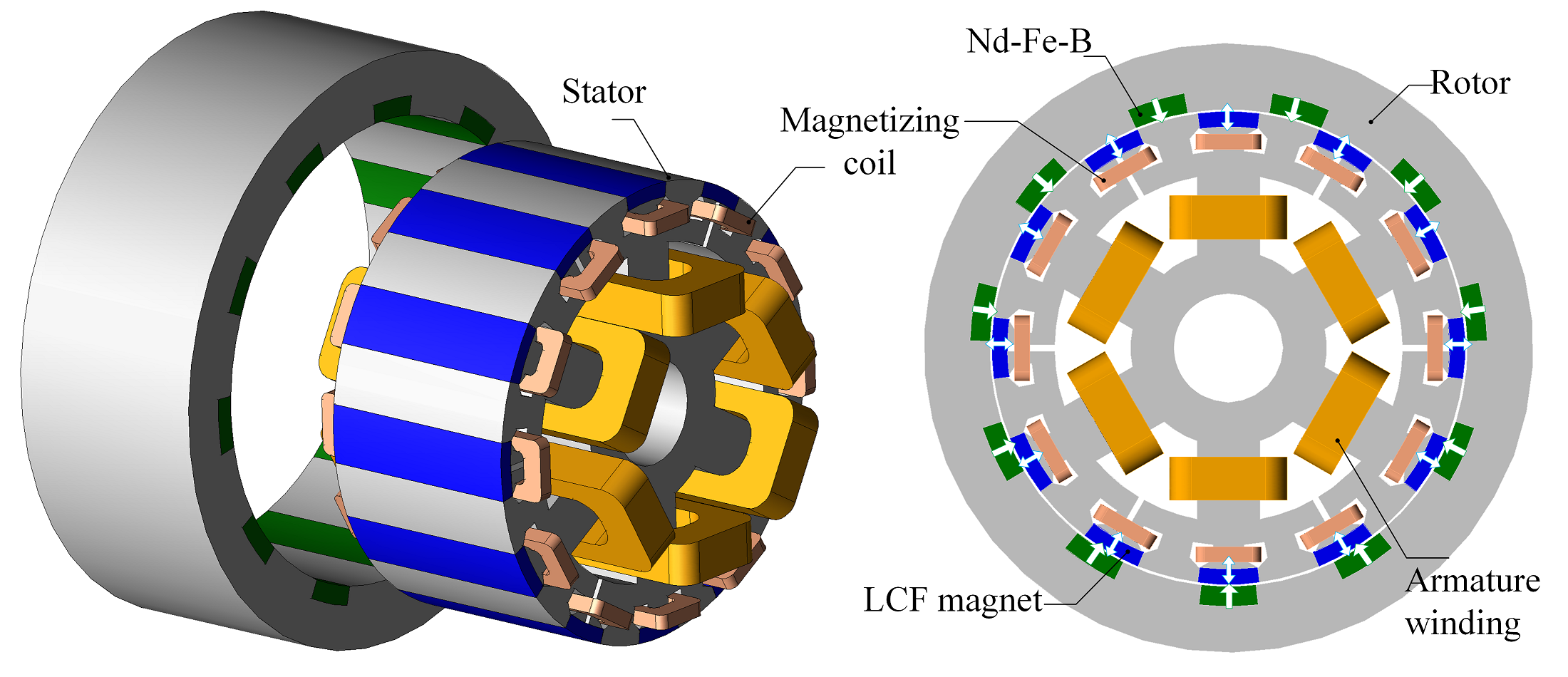
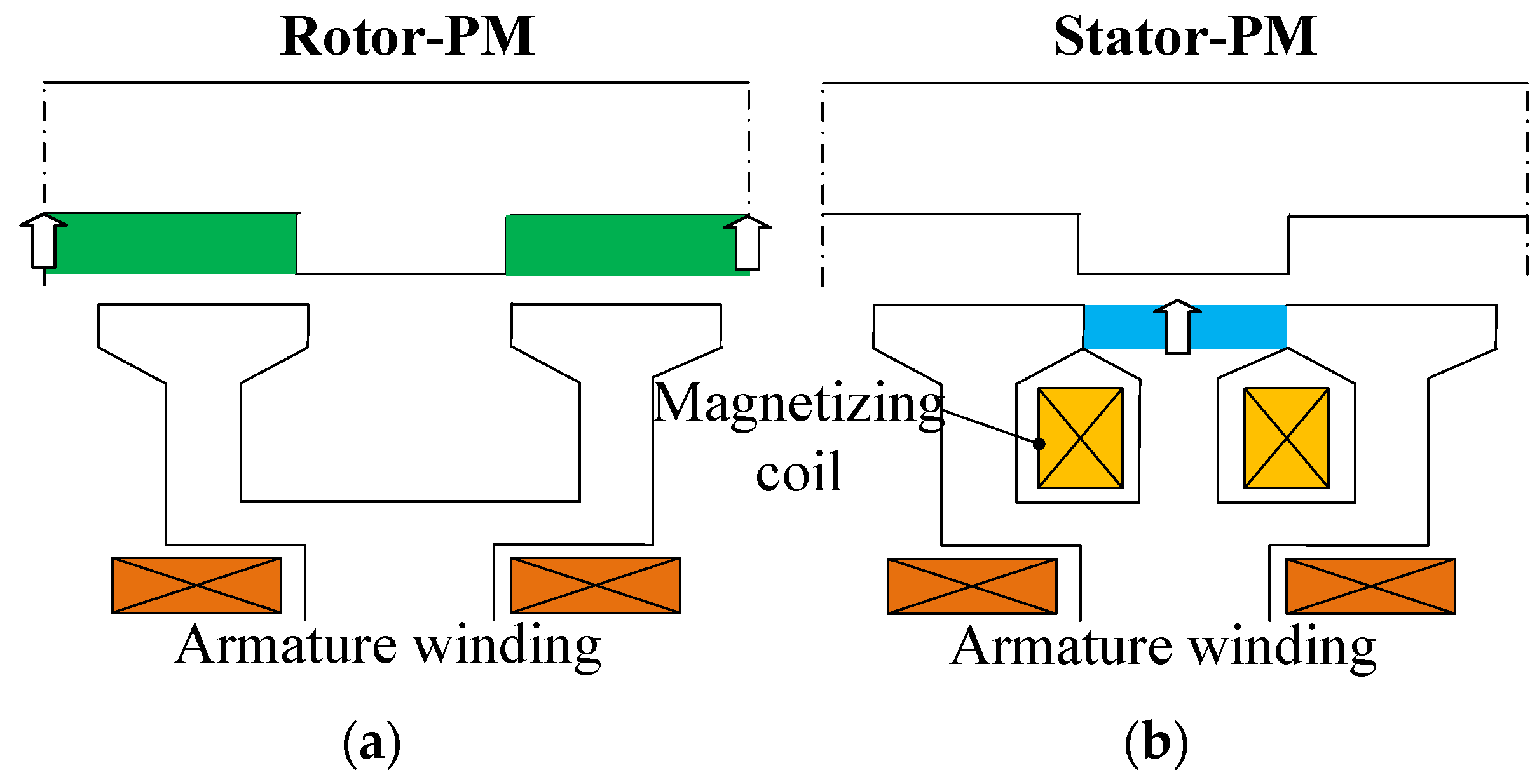
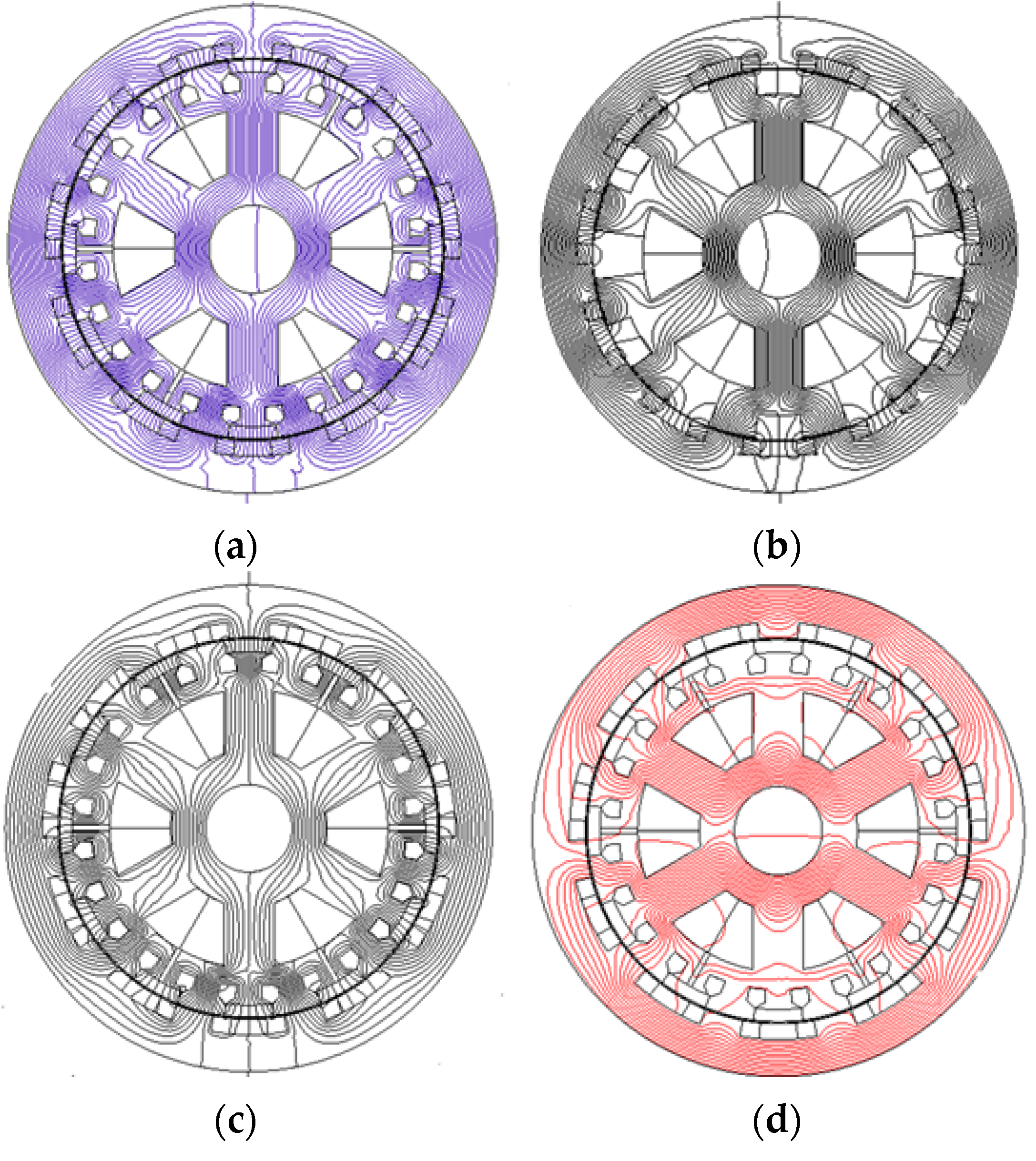
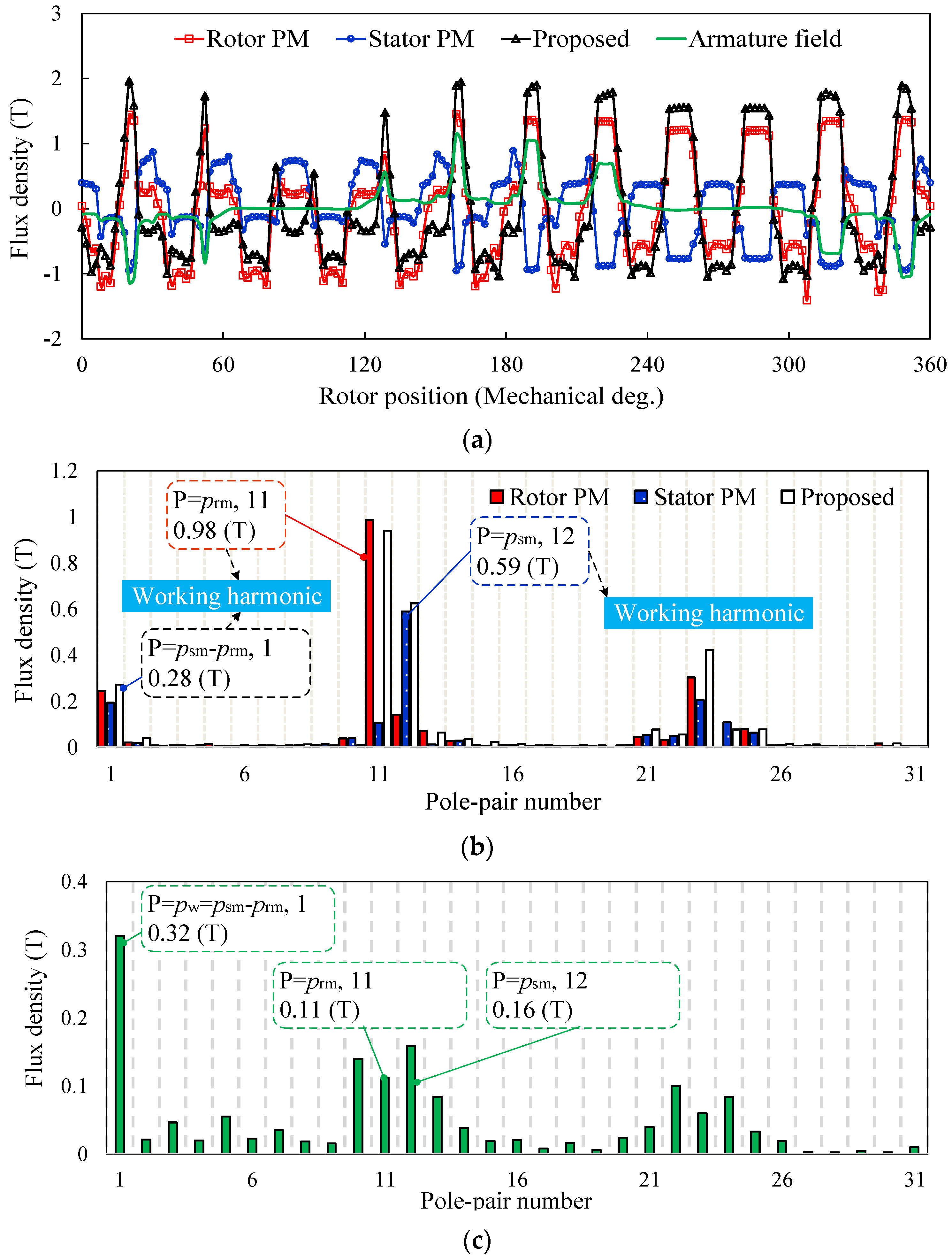
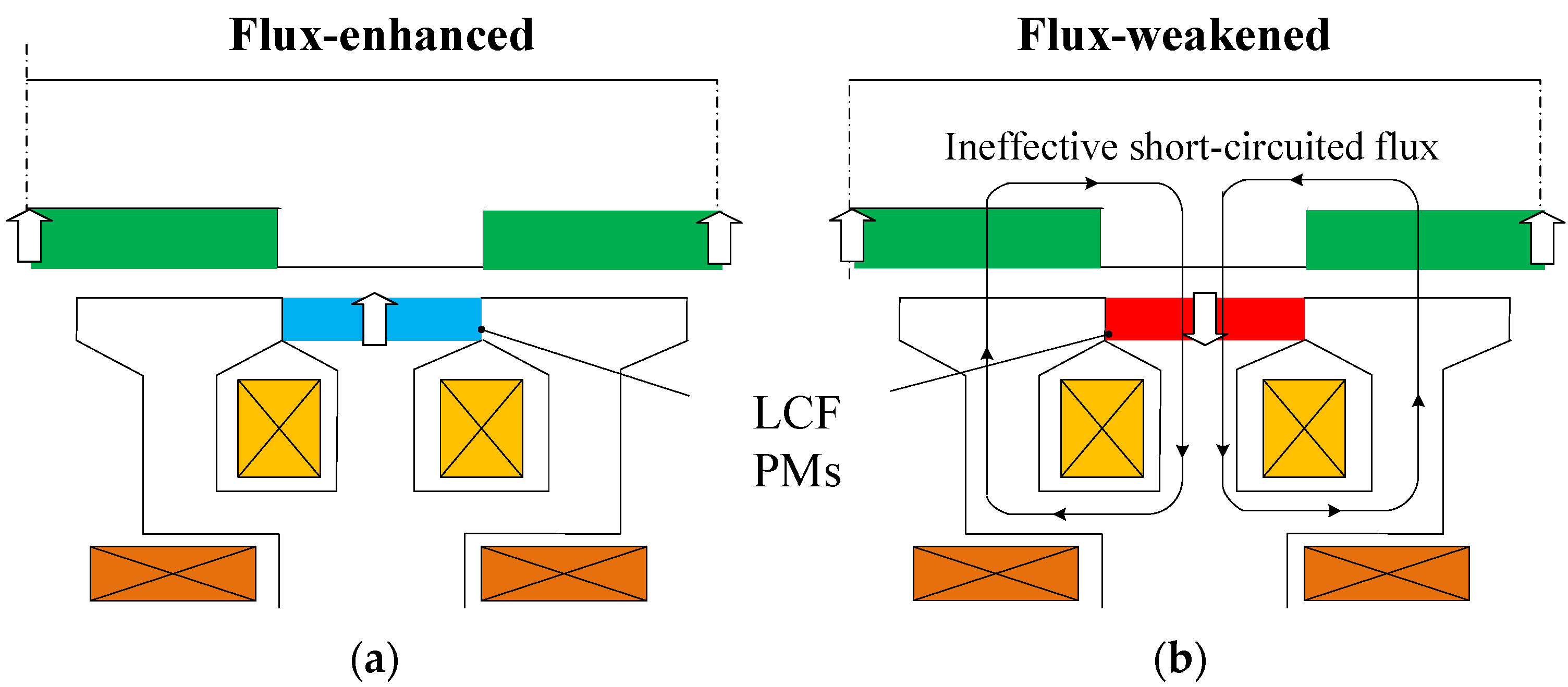


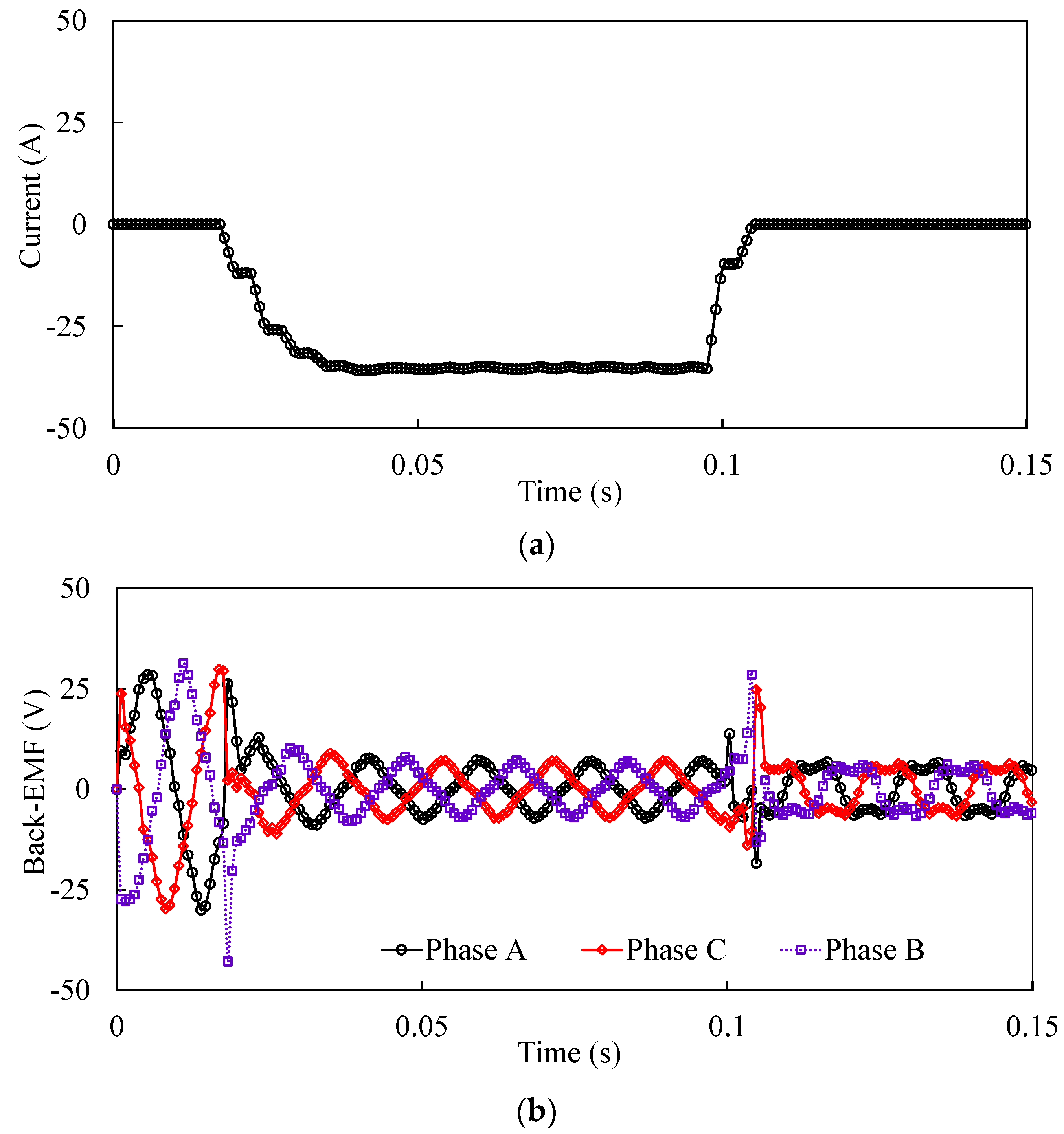
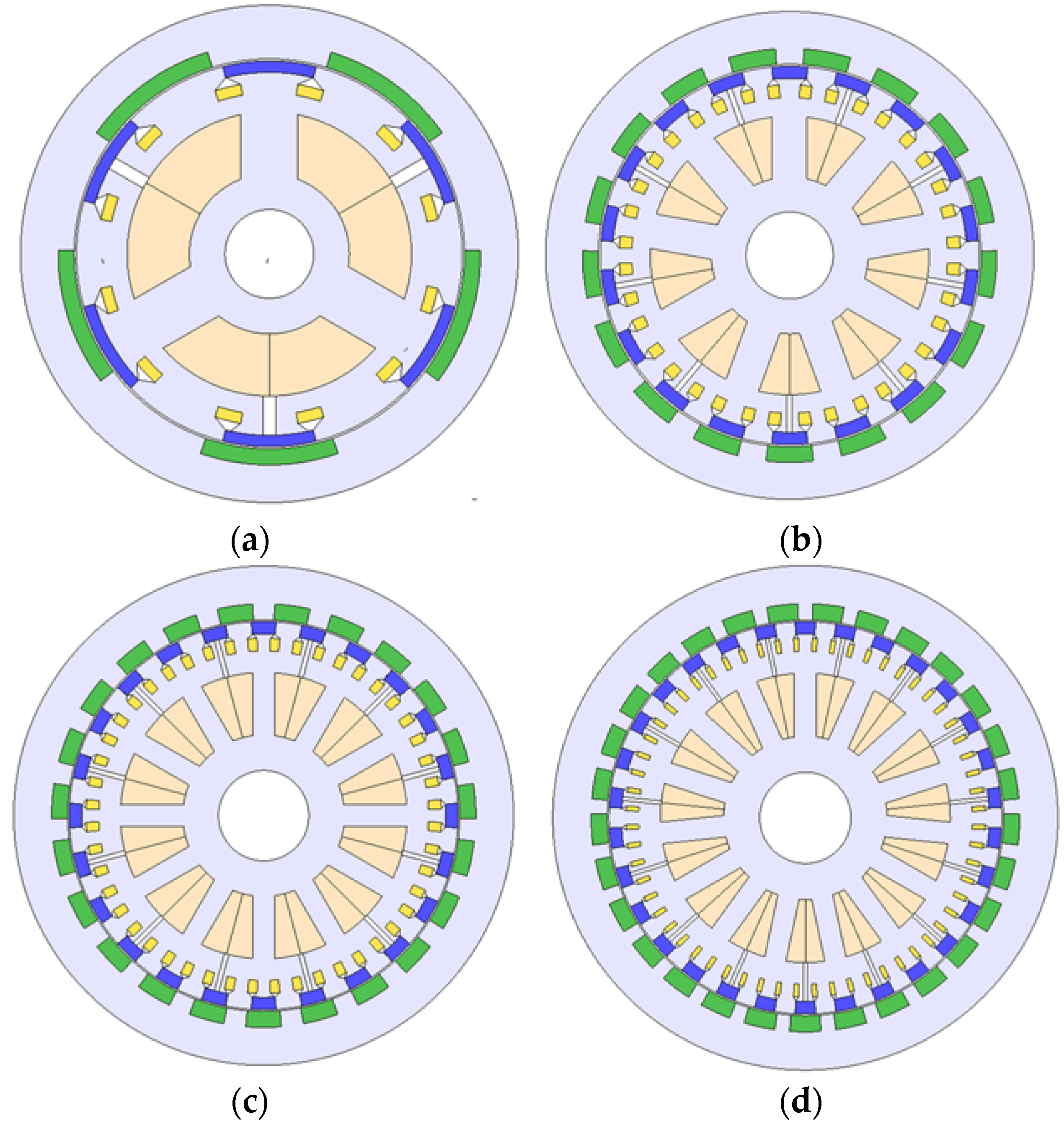
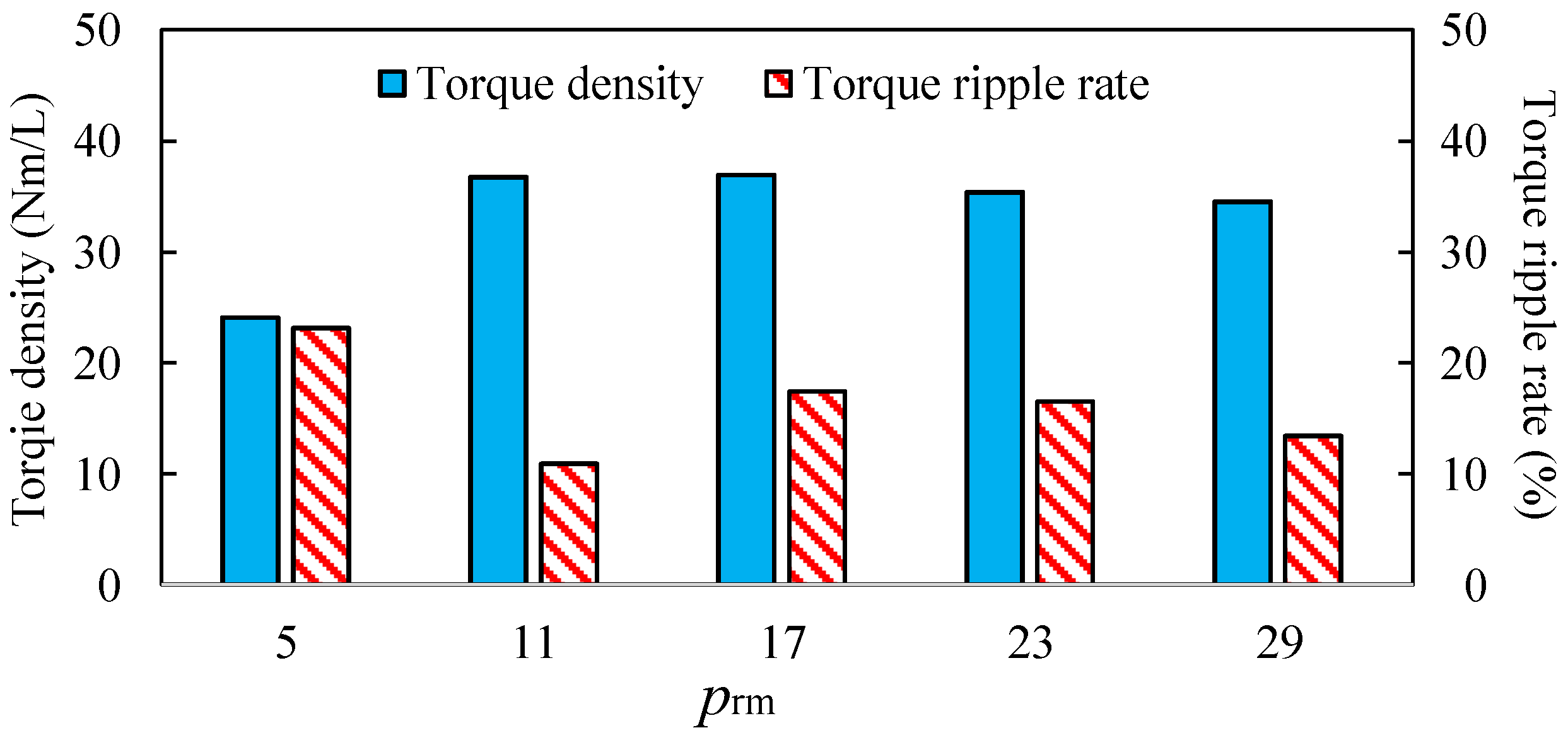
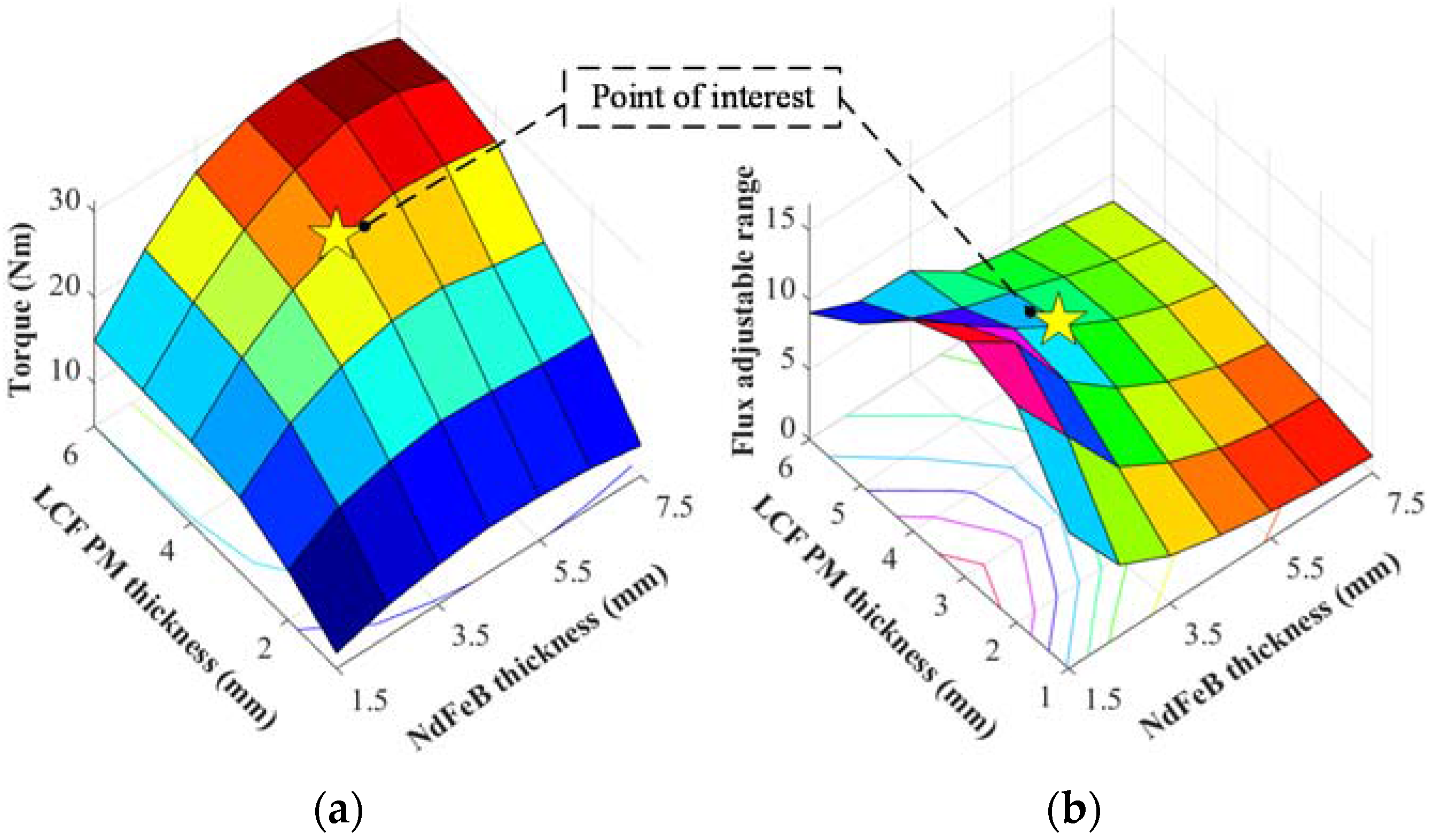



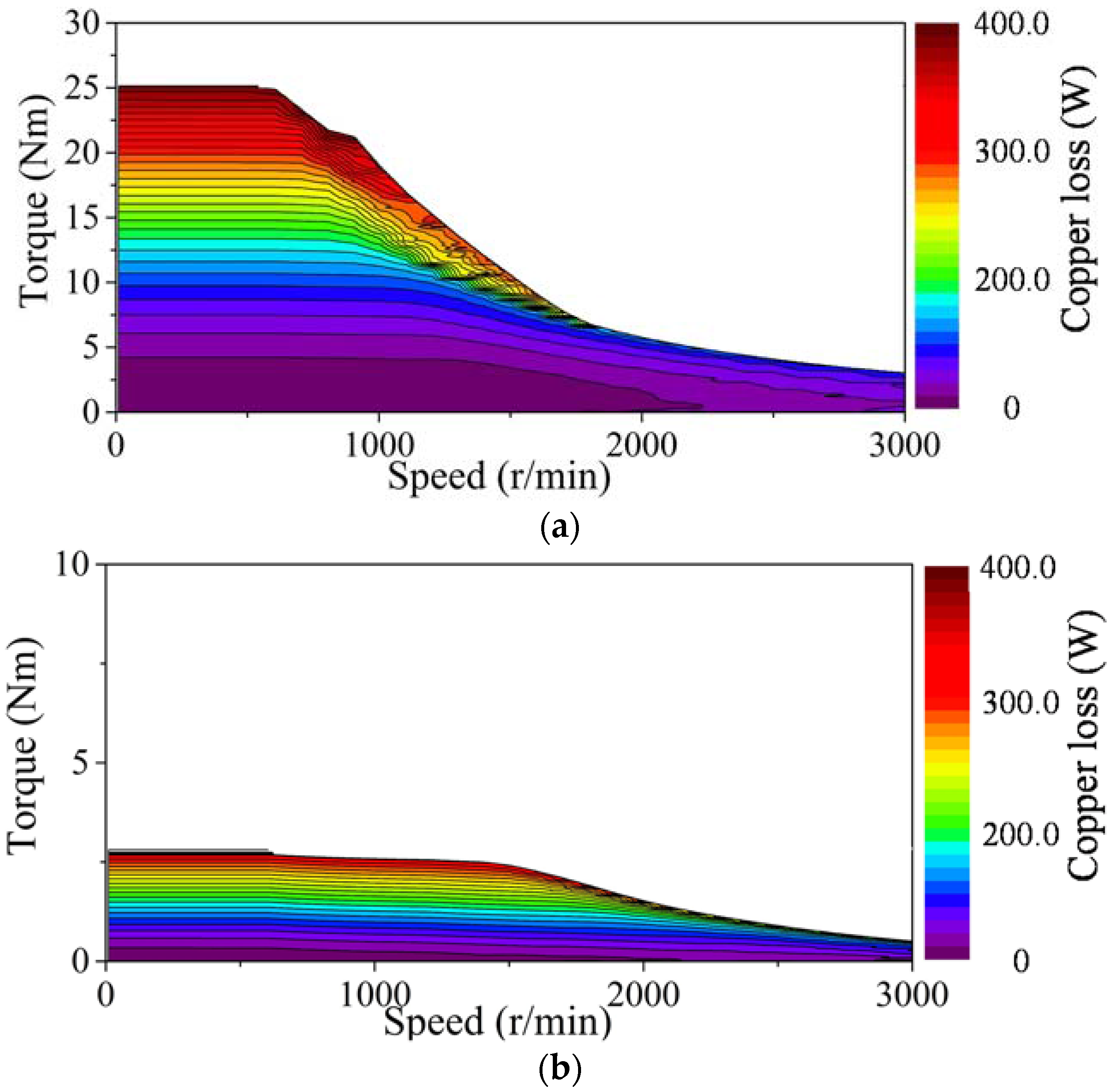

| Item | Parameter |
|---|---|
| Slot/pole number | 6/22 |
| No. of stator teeth | 2 × 6 |
| Rated speed (r/min) | 300 |
| Stack length (mm) | 50 |
| Outer radius of rotor (mm) | 70 |
| Air-gap length (mm) | 0.6 |
| NdFeB/LCF PM thick. (mm) | 4.5/4 |
| Split ratio | 0.7 |
| Stator/rotor pole arc (degree) | 20/11 |
| Rated current (A) | 10 |
| Power factor | 0.63 |
| NdFeB grade | N35 |
© 2016 by the authors; licensee MDPI, Basel, Switzerland. This article is an open access article distributed under the terms and conditions of the Creative Commons by Attribution (CC-BY) license (http://creativecommons.org/licenses/by/4.0/).
Share and Cite
Yang, H.; Lin, H.; Zhu, Z.-Q.; Fang, S.; Huang, Y. A Dual-Consequent-Pole Vernier Memory Machine. Energies 2016, 9, 134. https://doi.org/10.3390/en9030134
Yang H, Lin H, Zhu Z-Q, Fang S, Huang Y. A Dual-Consequent-Pole Vernier Memory Machine. Energies. 2016; 9(3):134. https://doi.org/10.3390/en9030134
Chicago/Turabian StyleYang, Hui, Heyun Lin, Zi-Qiang Zhu, Shuhua Fang, and Yunkai Huang. 2016. "A Dual-Consequent-Pole Vernier Memory Machine" Energies 9, no. 3: 134. https://doi.org/10.3390/en9030134








